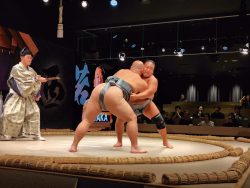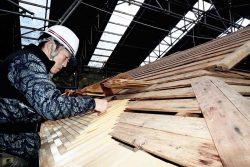
“Erica-chan,” a mascot of the northern territories, is modeled after a tufted puffin, a wild bird inhabiting Hokkaido.
17:53 JST, April 20, 2021
The northern territories, Takeshima islands in Shimane Prefecture and the Senkaku Islands in Okinawa Prefecture are inherent parts of Japan, based on both historical facts and international law.
We often hear such statements on the news, but do we fully understand the basis upon which they are made?
The government created the National Museum of Territory and Sovereignty as a means to provide relevant information about these territories and foster a better understanding of the situation both domestically and abroad.

Relief maps of the Senkaku Islands are on display. Museum staffers regularly offer explanations about the exhibits to visitors.
The museum initially opened in Hibiya, Chiyoda Ward, Tokyo, in January 2018, but it was relocated to a bigger facility in Kasumigaseki, also in Chiyoda Ward, in January of last year. The floor space has been expanded to seven times its original size — now measuring about 700 square meters — and the number of items on display has also increased.
Panels and materials are on display to explain the geography, history and diplomatic negotiations conducted thus far regarding the territories.
In 1945, Soviet forces invaded and occupied the northern territories — in violation of the Neutrality Pact between Japan and the USSR — forcing about 17,000 Japanese nationals who resided on those islands to leave by 1948.
Household items on display, from wooden snow sandals and a foot-warming hot-water bottle to an Ecchu Toyama’s medicine chest, provide a detailed portrayal of the struggles of the Japanese people who lived through cold winters on these islands.

Household utensils used by residents in the northern territories are on display.

One display features claims made by the other countries, with rebuttals by the Japanese side provided.
When the museum was relocated, particular attention was given to exhibiting displays that introduce and clearly explain the claims made by opposing parties and Japan’s arguments refuting those claims presented together with objective evidence and data.
Regarding the Takeshima islands, shortly before the San Francisco Peace Treaty came into effect in 1952 — an accord that confirmed the islands were Japan’s territory — South Korea unilaterally established the so-called Syngman Rhee Line — named after the South Korean president at the time — in the Sea of Japan in violation of international law and illegally occupied the islands.
Included in the materials on display is a report made by a special ambassador for the U.S. president. It notes that the United States and Japan also proposed to the South Koreans the idea of referring the dispute over the sovereignty of the Takeshima islands to the International Court of Justice in the interest of settling of the issue. The South Korean side rejected the proposal.
The Senkaku Islands were included in the Okinawa Reversion Agreement between Japan and the United States, which was signed in 1971. However, before the agreement came into effect, China and Taiwan had claimed sovereignty of the islands.
Even today, Chinese government ships have repeatedly made incursions into Japanese territorial waters.
To counter these claims, the museum displays administrative documents issued since the islands were lawfully incorporated into Japan in 1895. These documents include a letter of appreciation presented by a consul of the Republic of China stationed in Nagasaki to Japanese islanders who rescued shipwrecked Chinese fishermen who had drifted ashore one of the Senkaku Islands in the Taisho era (1912-1926).
In the letter, the consul clearly states “the Senkaku Islands in Yaeyama-gun, Okinawa Prefecture.”
Kozo Ishino of the museum said, “I would like people to compare the claims made by the Japanese government and the opposing countries and give thought to which side they feel is correct in its claims,” in trying to encourage people to visit the facility.

National Museum of Territory and Sovereignty
Toranomon Mitsui Building 1st floor, 3-8-1, Kasumigaseki, Chiyoda Ward, Tokyo
Related Tags
"Features" POPULAR ARTICLE
-

Students Recreate 19th-Century Bento Boxes Made for Ino Tadataka’s Survey Team in Hot Spring Town on Nakasendo Road
-

Santa Claus Delivers Christmas Presents to Penguins at Aquarium in Japan’s Nagasaki Prefecture
-

Sumo Restaurant in Tokyo Teaches Foreign Visitors About the Ancient Sport, with Bouts Between Retired Rikishi
-

Autonomous Passenger Ship Connects Mainland with Remote Island in Seto Inland Sea; World’s 1st Commercially Operated Autonomous Vessel
-

Osaka’s Sumiyoshi Taisha Shrine Bustles with New Year’s Visitors
JN ACCESS RANKING
-

As Chinese Tourists Shun Japan, Hotels and Stores Suffer
-

Osaka-Kansai Expo’s Economic Impact Estimated at ¥3.6 Trillion, Takes Actual Visitor Numbers into Account
-

Japan Govt Adopts Measures to Curb Mega Solar Power Plant Projects Amid Environmental Concerns
-

BOJ Gov. Ueda: Highly Likely Mechanism for Rising Wages, Prices Will Be Maintained
-

Economic Security Panels Debate Supply Chains, Rare Earths; Participants Emphasize Importance of Cooperation Among Allies

























